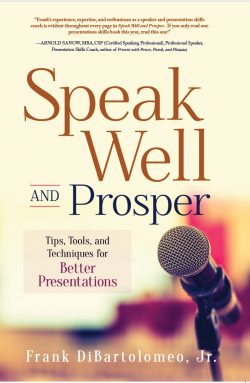Sunday, June 26, 2022

“Rapport is the ultimate tool for producing results with other people. No matter what you want in your life, if you can develop rapport with the right people, you’ll be able to fill their needs, and they will be able to fill yours.”
– Tony Robbins
Dictionary.com defines rapport as “relation; connection, especially harmonious or sympathetic relation.”
Readers of my articles know establishing rapport with your audience is a prerequisite to a successful presentation. Building a strong connection with your audience will significantly aid you in delivering your presentations.
Below are three methods you can use to establish, sustain, and increase your rapport with your audience:
Talk to Your Audience Before Your Presentation
The sooner you can make a connection with your audience, the better. So start doing this as soon as audience members enter the room.
I make it a regular practice to arrive at my presentation venues at least an hour before I will be speaking. I do this to ensure my computer is operating correctly, the projection or Smart TV is operable and connected to my laptop, and the seating arrangement is suitable for my presentation.
Doing this before anyone arrives frees you when attendees arrive to have short individual conversations with them. This is where rapport with your audience starts.
Some of you may be thinking you don’t know what to say when you meet a stranger. There was a book published several years ago called All I Really Needed to Know I Learned in Kindergarten.
What did you learn in Kindergarten? I learned how to meet other people. When you met another person for the first time in Kindergarten, what did you say to them? You probably said, “My name is ______. What’s your name.” It worked for you as a Kindergartener. It will work for you with your audience.
Below are some questions you can ask when you first meet your presentation attendees:
“What brought you here today?”
“What areas do you want addressed today?”
“What one thing, if it were addressed today, would make it worth your while to come?”
You can start with these and then improvise depending on the person’s answer.
You won’t have a lot of time to spend on anyone if you want to meet as many people as possible, but those you meet will appreciate you making an effort to meet them. You are starting to build rapport with them.
Your rapport with your audience would soar if you were able to intersperse attendees’ answers to your “before your presentation” questions during your presentation. It means you listened to them and are addressing their primary needs from your presentation. As a result, you have instantly increased the relevancy of your presentation to your audience.
So, talking to your audience before your presentation provides valuable audience-centric information you can address “on the fly” in your presentation. It also increases your rapport with your audience.
The next method to establish rapport with your audience is to share your background (personal and professional) with the audience.
Share Your Background (Personal and Professional) with Your Audience
Have you ever met a person who went to the same college, grew up in the same town, or has a love of music like you do? Did you feel an instant connection with this person? Did you want to learn more about this person?
It’s likely your answer to all three questions is “Yes.” What you feel when you talk to this person are the beginnings of rapport with your audience. This is the feeling you want your audience to have. You want them to feel you are one of them. People listen to people who they think are like them.
Continue to nurture this rapport as soon as you start your presentation. At the beginning of your presentation, share your personal and professional background. If you have been out in the working world for a while, it is likely, most of your audience will have something in common with you.
As a speaker and a student of body language (includes facial expressions and gestures) and if you have established rapport with your audience, you will see some in your audience giving you the “Oh, I have something in common with the speaker” look. It may be a nodding of the head, a smile, or other facial expressions expressing approval of what you are saying.
Sharing your personal and professional background is needed even more when speaking virtually because you are not in the same room as your audience. It is harder to read their body language because so much of it is hidden in the virtual video box.
In this high-tech, social media-driven, separated world of ours, people are craving connections to others. When you connect with your audience, you satisfy one of their essential needs.
Encourage Audience Questions During Your Presentation
Some public speakers cringe when someone in the audience asks a question. Audience questions are a gift from your audience. Remember, the more you know about your audience, the more relevant you can make your presentation “on the fly.” Audience questions give clues as to what the audience thinks about your presentation subject.
Never equate audience silence with concurrence. If your audience is not asking questions, then ask questions of your audience. This will usually, at least, will engender answers from your audience and, at best, will stir them to ask you questions.
Some speakers tell their audience they will take questions at the end of their presentation. This is unfortunate. Audience questions give you clues on how to change your “voice track” “on the fly” to make your presentation as relevant to your audience as possible. You miss this golden opportunity if you don’t take questions from your audience during your presentation.
Some speakers would say they will go over time if they take questions during their presentation. I have two solutions to this: (1) Plan your presentation to take only 80% of your allotted time, and (2) tell the “long-winded” audience questioner that, in the interests of time, you will have to see them at the break to address their question fully.
The best method to answer audience questions is to repeat the audience question. This does a few things for you. Number one, some audience members might not have heard the question. Number two, it confirms you heard the question correctly. Finally, it gives you time to formulate your answer.
Answer the audience question fully and then stop answering the question. Unfortunately, some speakers talk way past answering the question. This is a waste of your’s and, more importantly, your audience’s time.
We have talked about three methods to establish, sustain, and increase your rapport with your audience: (1) talk to your audience before your presentation, (2) share your personal and professional background with your audience, and (3) encourage the audience questions during your presentation.
Earl Nightingale said, “The only requirement of a speaker is to be interesting.”
Your presentation will be interesting if you establish, maintain, and increase your rapport with your audience.
Rapport with your audience is the key to your presentation success!
Call to Action
Make a point to always arrive at your presentation’s venue early before any attendees arrive to set up your presentation; this will allow you to mix with your audience before your presentation – the beginning of establishing rapport with your audience
Always share your personal and professional background at the beginning of all of your presentations to build on the rapport you established before your presentation
Encourage audience questions during your presentation to obtain clues of what your audience is interested about your presentation subject; then give them what they are interested in through your “voice track”
“The best way to establish rapport with people and to win them over to your side is to be truly interested in them, to listen with the intention of really learning about them. When the person feels that you are really interested in getting to know them and their feelings, they will open up to you and share their true feelings with you much more quickly.”
– Jack Canfield
_____________________________ Frank DiBartolomeo is a retired U.S. Air Force Lieutenant Colonel and award-winning speaker, presentation and interview skills coach, and Professional Member of the National Speakers Association. He was awarded Toastmasters International’s highest individual award, Distinguished Toastmaster because of his outstanding work in public speaking and leadership.
Frank formed DiBartolomeo Consulting International (DCI), LLC (www.speakleadandsucceed.com) in 2007. The mission of DCI is to help technical professionals to inspire, motivate, and influence their colleagues and other technical professionals through improving their presentation skills, communication, and personal presence. Reach Frank at frank@speakleadandsucceed.com and (703) 509-4424.
_____________________________ Don’t miss Frank DiBartolomeo’s latest book!
“Speak Well and Prosper: Tips, Tools, and Techniques for Better Presentations”

Available now at Amazon.com and BarnesandNoble.com